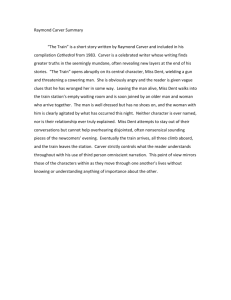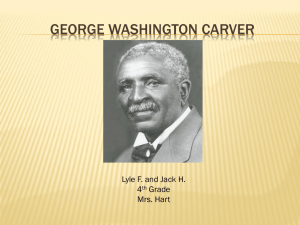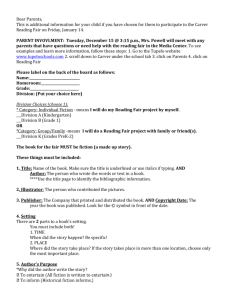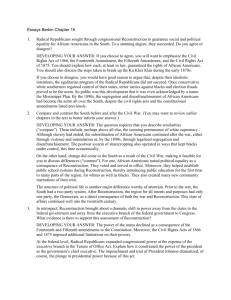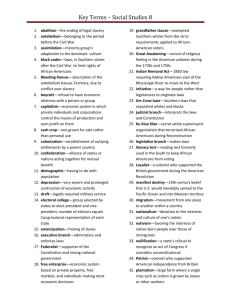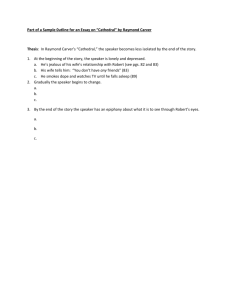4_3USH
advertisement
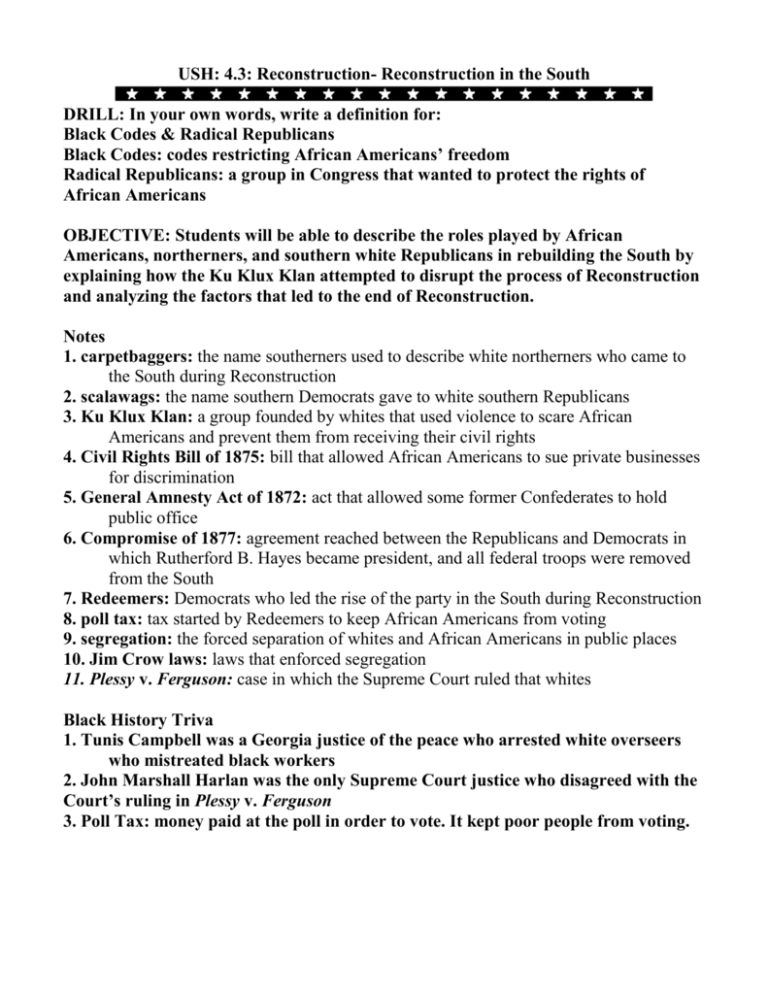
USH: 4.3: Reconstruction- Reconstruction in the South DRILL: In your own words, write a definition for: Black Codes & Radical Republicans Black Codes: codes restricting African Americans’ freedom Radical Republicans: a group in Congress that wanted to protect the rights of African Americans OBJECTIVE: Students will be able to describe the roles played by African Americans, northerners, and southern white Republicans in rebuilding the South by explaining how the Ku Klux Klan attempted to disrupt the process of Reconstruction and analyzing the factors that led to the end of Reconstruction. Notes 1. carpetbaggers: the name southerners used to describe white northerners who came to the South during Reconstruction 2. scalawags: the name southern Democrats gave to white southern Republicans 3. Ku Klux Klan: a group founded by whites that used violence to scare African Americans and prevent them from receiving their civil rights 4. Civil Rights Bill of 1875: bill that allowed African Americans to sue private businesses for discrimination 5. General Amnesty Act of 1872: act that allowed some former Confederates to hold public office 6. Compromise of 1877: agreement reached between the Republicans and Democrats in which Rutherford B. Hayes became president, and all federal troops were removed from the South 7. Redeemers: Democrats who led the rise of the party in the South during Reconstruction 8. poll tax: tax started by Redeemers to keep African Americans from voting 9. segregation: the forced separation of whites and African Americans in public places 10. Jim Crow laws: laws that enforced segregation 11. Plessy v. Ferguson: case in which the Supreme Court ruled that whites Black History Triva 1. Tunis Campbell was a Georgia justice of the peace who arrested white overseers who mistreated black workers 2. John Marshall Harlan was the only Supreme Court justice who disagreed with the Court’s ruling in Plessy v. Ferguson 3. Poll Tax: money paid at the poll in order to vote. It kept poor people from voting. USH: 4.3: Reconstruction- Reconstruction in the South 1. c 2. e 3. i 4. f 5. a 6. k 7. j 8. b 9. l 10. g Identify: 11. Ku Klux Klan: a group that used violence to scare African Americans 12. Civil Rights Bill of 1875: allowed African Americans to sue for discrimination 13. General Amnesty Act of 1872: allowed former Confederates to hold public office 14. Compromise of 1877: agreement in which Rutherford B. Hayes became president, and all federal troops were removed from the South 15. Redeemers: Democrats who led the rise of the party in the South 16. Poll Tax: money paid at the poll in order to vote. It kept poor people from voting. 17. Segregation: kept whites and African Americans separate 18. Jim Crow: nickname for the laws that enforced segregation 19. Plessy v. Ferguson: 1898 Supreme Court case, enabled segregation if the facilities were of equal. BIOGRAPHY: George Washington Carver 1. moved around the Midwest where he attended various grade schools and worked at odd jobs to support himself; later attended Simpson College and Iowa State Agricultural College 2. piano and art; wanted to study agriculture full time 3. taught classes, conducted research, supervised an experimental farm, published bulletins offering advice to farmers, established a “movable school of agriculture” 4. because they are high in protein and restore nitrogen to the soil 5. a fund for agricultural research at Tuskegee Summary: In today’s lesson, we described the roles played by African Americans, northerners, and southern white Republicans in rebuilding the South, we also explained how the Ku Klux Klan attempted to disrupt the process of Reconstruction, and analyzed the factors that led to the end of Reconstruction. Homework: Carpetbaggers& Scalawags Carpetbaggers: the name southerners used to describe white northerners who came to the South during Reconstruction Scalawags: the name southern Democrats gave to white southern Republicans Name __________________________ Class _______________ Date ________________ USH: 4.3: Reconstruction - Reconstruction in the South MATCHING: Match each of the following people or terms with the correct description by writing the letter of the description in the space provided. Some descriptions will not be used. ______ 1. carpetbaggers ______ 6. poll tax ______ 2. Tunis Campbell ______ 7. segregation ______ 3. Ku Klux Klan ______ 8. Jim Crow laws ______ 4. Civil Rights Act of 1875 ______ 9. Plessy v. Ferguson ______ 5. Redeemers _____10. John Marshall Harlan a. individuals behind the Democratic Party’s return to power in the South at the end of Reconstruction b. nickname for laws in southern states that required African Americans to stay in different hotels than whites, to sit n separate theater sections, and to ride in separate rail cars c. northern-born Republicans who came South right after the war d. name given to southern Republicans by southern Democrats because the Democrats considered them to be liars and cheats e. Georgia justice of the peace who arrested white overseers who mistreated black workers f. law that allowed African Americans to sue private businesses for discrimination g. only Supreme Court justice who disagreed with the Court’s ruling in Plessy v. Ferguson h. person who was president of the United States at the time that Reconstruction ended i. secret society whose purpose was to drive the Republicans out of the South and to deny African Americans equal rights j. forced separation of whites and African Americans in public places k. way in which Redeemers denied the vote to African Africans by requiring individuals to pay a special tax before they could vote l. “separate-but-equal” argument that gave segregation the backing of the U.S. Supreme Court. Identify the following terms in your words 11. Ku Klux Klan 12. Civil Rights Bill of 1875 13. General Amnesty Act of 1872 14. Compromise of 1877 15. Redeemers 16. Poll Tax 17. Segregation 18. Jim Crow 19. Plessy v. Ferguson BIOGRAPHY READING: George Washington Carver George Washington Carver was a distinguished African American teacher and scientist. He developed more than 300 uses for the peanut and some 118 for the sweet potato. His agricultural research benefited many southern farmers, who were too dependent on growing cotton. George Washington Carver was born near Diamond Grove, Missouri, to slave parents. The exact date of his birth is unknown, but it was probably sometime in 1864. His father died shortly after Carver was born. While still an infant, Carver and his mother were kidnapped by slave raiders from Arkansas. He was soon brought back to Diamond Grove by a neighbor, but he never saw or heard from his mother again. Carver was taken in by Moses and Susan Carver, his mother’s former owners. The Carvers gave him their last name and raised him like their own son. From an early age, George Carver displayed a sharp intellect and a deep interest in nature. However, African Americans were not allowed to attend the local grammar school. Thus, when he was about 12 years old, he left Diamond Grove in search of a formal education. Carver spent the next several years moving around the Midwest, where he attended various grade schools and worked at odd jobs to support himself. He went to high school during the early 1880s in Minneapolis, Kansas. In 1885 he was again refused admission to a school—this time a small college in Kansas—because of his race. After five more years working as a farmer, hotel cook, and laundryman, Carver was finally admitted to Simpson College in Indianola, Iowa, in 1890. Carver studied piano and art while he was at Simpson College, but in 1891 he decided to study agriculture full time. He transferred to Iowa State Agricultural College, where he received a bachelor’s degree in agricultural science in 1894 and a master of science degree in 1896. While a student at Iowa State, Carver gained a reputation as an extremely gifted student of botany, or plant science. In 1896 Carver accepted a job as director of a new agricultural department at the Tuskegee Institute, a college and vocational school for African Americans in Alabama. He had been hired by Booker T. Washington, a well-known African American educator. Carver would remain on the Tuskegee faculty for the rest of his life. Carver’s schedule at Tuskegee was a busy one. Along with teaching classes, conducting research, and supervising an experimental farm, he published bulletins offering advice to farmers. He also established a “movable school of agriculture” that provided equipment, field demonstrations, and home economics classes to poor farmers in Alabama. Carver’s most famous work, however, dealt with peanuts. He believed that southern farmers devoted too much land to raising cotton, a cash crop that depleted the soil of nutrients. He urged them to grow a variety of staple crops instead. Peanuts were an especially good crop to grow, Carver explained, because they were high in protein and restored nitrogen (a nutrient necessary for plants) to the soil. In an effort to make peanuts more profitable for farmers, Carver set up a laboratory devoted to finding new uses for them. Throughout his career, he developed more than 300 peanut-based products, including new types of flour, ink, dye, plastic, soap, cosmetics, and medicine. In 1940 Carver used his life savings to establish the George Washington Carver Foundation, a fund for agricultural research at Tuskegee. He died of anemia in early 1943. Later that year, his birthplace was made a national monument by Congress. UNDERSTANDING WHAT YOU READ After you have finished reading the selection, answer the following questions in the space provided. 1. How did Carver obtain his early education? 2. What subject did Carver study at Simpson College? Why did he transfer to Iowa State? 3. What were five of Carver’s activities at the Tuskegee Institute? 4. Why did Carver think southern farmers should grow peanuts? 5. What was the George Washington Carver Foundation? In your own words, summarize today’s lesson.

